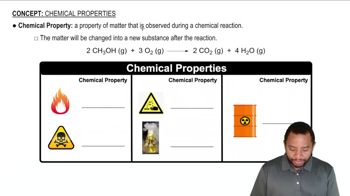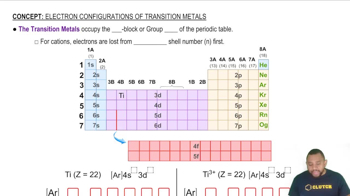Write a balanced equation for the reaction that occurs in each of the following cases: (a) Potassium metal is exposed to an atmosphere of chlorine gas.
Ch.7 - Periodic Properties of the Elements
Chapter 7, Problem 70a
Write a balanced equation for the reaction that occurs in each of the following cases: (a) Cesium is added to water.
 Verified step by step guidance
Verified step by step guidance1
Identify the reactants and products: Cesium (Cs) reacts with water (H2O) to form cesium hydroxide (CsOH) and hydrogen gas (H2).
Write the unbalanced chemical equation: Cs + H2O -> CsOH + H2.
Balance the equation by adjusting coefficients to ensure the same number of each type of atom on both sides of the equation.
Start by balancing the cesium atoms: Place a coefficient of 2 in front of CsOH to balance the hydroxide ions.
Balance the hydrogen atoms by placing a coefficient of 2 in front of H2O, and then adjust the coefficient of H2 to balance the hydrogen atoms.

Verified video answer for a similar problem:
This video solution was recommended by our tutors as helpful for the problem above.
Video duration:
1mWas this helpful?
Key Concepts
Here are the essential concepts you must grasp in order to answer the question correctly.
Chemical Reactions
A chemical reaction involves the transformation of reactants into products through the breaking and forming of chemical bonds. In this case, the reaction between cesium and water is a type of single displacement reaction, where cesium displaces hydrogen from water, leading to the formation of cesium hydroxide and hydrogen gas.
Recommended video:
Guided course

Chemical Properties
Balancing Chemical Equations
Balancing a chemical equation ensures that the number of atoms for each element is the same on both sides of the equation, adhering to the law of conservation of mass. This involves adjusting coefficients in front of compounds to achieve equal atom counts, which is crucial for accurately representing the reaction.
Recommended video:
Guided course

Balancing Chemical Equations
Reactivity of Alkali Metals
Alkali metals, such as cesium, are highly reactive, especially with water. This reactivity increases down the group in the periodic table, leading to vigorous reactions that produce hydroxides and hydrogen gas. Understanding this reactivity is essential for predicting the products and the nature of the reaction when cesium is added to water.
Recommended video:
Guided course

Transition Metals
Related Practice
Textbook Question
1
views
Textbook Question
Write a balanced equation for the reaction that occurs in each of the following cases: (b) Strontium oxide is added to water. (c) A fresh surface of lithium metal is exposed to oxygen gas. (d) Sodium metal reacts with molten sulfur.
1
views
Textbook Question
Write a balanced equation for the reaction that occurs in each of the following cases: (c) Sodium reacts with oxygen.
1
views
Textbook Question
(a) As described in Section 7.7, the alkali metals react with hydrogen to form hydrides and react with halogens to form halides. Compare the roles of hydrogen and halogens in these reactions. Write balanced equations for the reaction of fluorine with calcium and for the reaction of hydrogen with calcium. (b) What is the oxidation number and electron configuration of calcium in each product?
